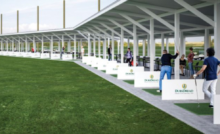University of Minnesota golf course could become national model for greener practices (Aug 30)
August 30, 2015 – A University of Minnesota scientist says many golf courses could be a lot more friendly to the environment if they were engineered to use different turf grasses that require less water and fewer chemicals. Turf grass specialist and Prof. Brian Horgan wants to use 14 years of research to convert the university’s entire Les Bolstad Golf Course to those practices, making it a national model for thousands of other aging courses that need to be renovated.
“This is an area that’s ripe for leadership,” Horgan said, since about one-third of the nation’s 15,000 golf courses need to be renovated in the next few years with updated drainage and irrigation systems and other improvements.
Horgan said some courses, especially in Minnesota and other northern states, might benefit from switching grasses, as well. Most links usually plant bentgrass, Kentucky bluegrass or some of each.
But a different type – fine fescue grasses – typically require less water, less fertilizer, fewer pesticides and less frequent mowings. Horgan and others have been studying different varieties of fescue as part of the “Science of [the] Green” initiative.
“We’re trying to make sure we’re identifying the best way to be better stewards for the environment by utilizing the right grasses and using the right management systems,” he said. Sustainability includes both economic and environmental stewardship.
Golf courses often have about 100 acres of managed turf, including 30 acres of –fairways and 50 acres of rough, Horgan said.
“You can make a really big dent in the amount of resources required to manage that golf course by identifying alternative grass species for just those two areas,” he said.
Horgan said that although fine fescues offer many advantages, at least in some parts of the country, they also have some weaknesses. Because fescues have less density and a firmer surface, more water runs off, potentially into streams or ponds, unless buffer zones are created. Fescues also grow more slowly, meaning that divots, the chunks of grass removed during golf swings, don’t grow back as quickly. And many have a duller green than golfers are accustomed to.
Fescues also are more easily damaged by golf cart traffic, said Eric Watkins, University of Minnesota associate professor and turf grass breeder, who works with Horgan.
But Watkins said that fine fescues overall seem to “hit the mark” for use in Minnesota, and he and others are studying whether some of the weaknesses can be overcome by mixing fescue varieties, breeding or other strategies.
Watkins said it’s time to increase some of the research and see how alternative grasses behave on a fully –functioning golf course, such as the Les Bolstad links.
“A lot of golf course superintendents want to see what these grasses look like and play like on real fairways, and how they’re managed on a wider scale,” he said. “Maybe the grasses play a little differently, and we could also learn more about what golfers think.”
Mark Johnson, associate director of environmental programs for the Golf Course Superintendents Association of America, said that Science of [the] Green and turf grass research at other universities have been important in the past and will be even more significant in the future.
“A golf course is a professionally managed landscape,” he said, “and these are all steps in the right direction as we talk about sustainable operations and proper use of natural resources.”
’Ahead of the curve’
Johnson said the golf industry is doing its part and is “ahead of the curve” in funding turf grass research and making changes, but in some parts of the country is facing greater regulations on fertilizer use and proposed restrictions on certain pesticides.
Horgan and Watkins will continue to research different properties of fescues and other grasses, and said that no decision has been made yet about whether the Les Bolstad golf course will eventually become a living laboratory for them and others across the country. It also is unclear whether different grass might be used on putting greens and tee boxes, which constitute about 4 acres on a typical golf course.
U regents have included renovation of the Les Bolstad Golf Course in their six-year capital plan, but will need to make more specific decisions. Horgan said the renovation he’s proposing will require full administrative support and private funding.
Adding interest to the potential project is the California drought and water shortages elsewhere, Watkins said. Typically those golf courses use different grasses, he said, but the historically dry conditions are helping golfers, businesses, farmers and the general public to understand the importance of conserving water everywhere.
“It’s certainly affecting the way that people think about how we use water on landscapes, even here in Minnesota,” Watkins said.
Recent Posts
Memphis Country Club: A Golfer’s Study in Precision and Tradition
If you have ever teed it up at Memphis Country Club, you know this isn’t…
Foley Company attains GCSAA Silver Partner Status
Foley Company, a leader in turf equipment innovation and technology, affirms its support of the…
Harrell’s continues longstanding support of the GCSAA Foundation
Harrell’s LLC, a leading distributor of customized agronomic products for turfgrass since 1941, has donated…
City of Orlando Announces New State-of-the-Art Driving Range at Dubsdread Golf Course
The City of Orlando is excited to announce the construction of a brand-new, state-of-the-art driving…
Discover Puerto Rico for Great Golf Trips and After-Round Activities, Amenities
Golfers cannot live by the game alone which is why Puerto Rico provides the perfect…
Q&A with a Multi-talented Golf Course Architect – Part 2: Making the Rounds – Installment 39
This column features recollections of the author’s 37 years as a golf writer. These installments…



